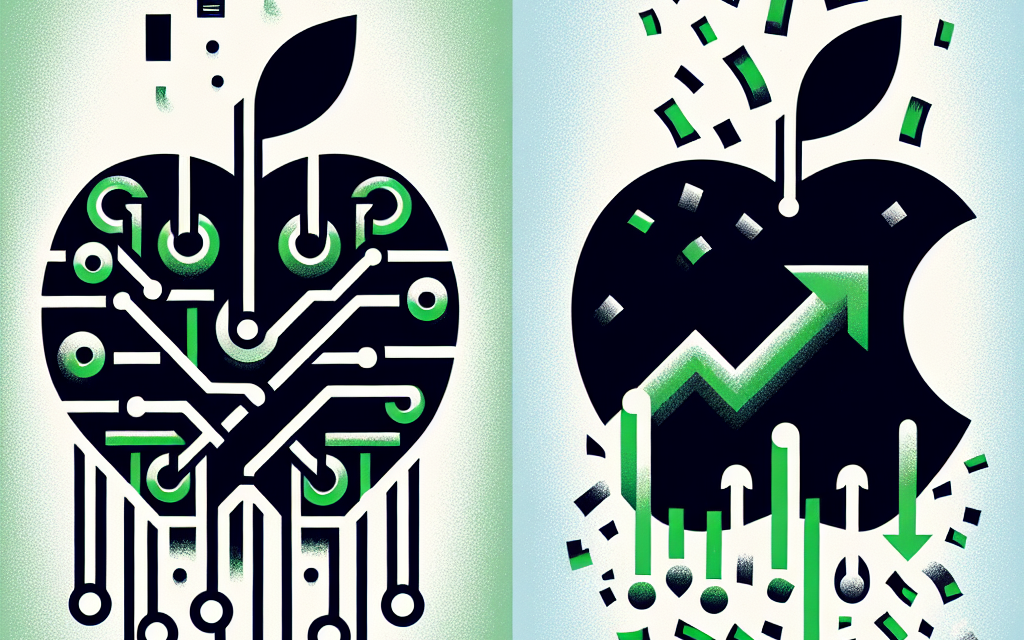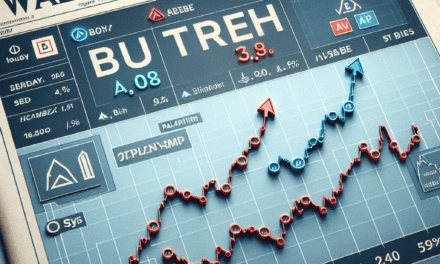“Dow Jones Update: Nvidia Dips and Apple Faces Market Pressure.”
Introduction
The Dow Jones Industrial Average experienced notable fluctuations as Nvidia’s stock declined, reflecting concerns over its growth prospects amid a competitive landscape. Simultaneously, Apple faced a sell-off, driven by investor apprehensions regarding its market performance and future earnings potential. These developments highlight the ongoing volatility in the tech sector and its impact on broader market trends.
Nvidia’s Recent Decline: Causes and Implications
In recent weeks, Nvidia has experienced a notable decline in its stock price, prompting analysts and investors to scrutinize the underlying causes and potential implications of this downturn. The semiconductor giant, which has been a key player in the technology sector, particularly in graphics processing units (GPUs) and artificial intelligence (AI), has seen its shares fluctuate significantly. This volatility can be attributed to a combination of factors, including market corrections, shifts in demand, and broader economic conditions.
One of the primary reasons for Nvidia’s recent decline is the overall market correction that has affected many technology stocks. After a period of remarkable growth, driven largely by the surge in demand for AI and gaming technologies, investors began to reassess valuations. As a result, Nvidia’s stock, which had reached all-time highs, faced increased selling pressure. This correction reflects a broader trend in the market, where investors are becoming more cautious amid rising interest rates and inflationary concerns. Consequently, Nvidia’s stock price has been impacted as investors recalibrate their expectations for future growth.
Moreover, Nvidia’s dependence on the gaming sector has also contributed to its recent struggles. While the gaming industry has seen substantial growth, there are signs that demand may be stabilizing after a period of unprecedented expansion during the pandemic. As consumers return to pre-pandemic spending habits, the surge in GPU sales may not be sustainable. This shift in consumer behavior raises questions about Nvidia’s ability to maintain its growth trajectory, leading to increased uncertainty among investors.
In addition to these market dynamics, Nvidia faces heightened competition in the AI and data center markets. As more companies enter the AI space, the competitive landscape is becoming increasingly crowded. Rivals are not only developing their own advanced chips but are also innovating in software and cloud services, which could potentially erode Nvidia’s market share. This intensifying competition has led to concerns about Nvidia’s ability to sustain its leadership position, further contributing to the stock’s decline.
Furthermore, geopolitical tensions and supply chain disruptions have added another layer of complexity to Nvidia’s operational landscape. The ongoing semiconductor shortage, exacerbated by global supply chain issues, has affected many technology companies, including Nvidia. While the company has made strides to mitigate these challenges, the uncertainty surrounding supply chain stability continues to weigh on investor sentiment. As a result, the stock’s decline can also be viewed as a reflection of broader economic uncertainties that are impacting the technology sector as a whole.
In light of these factors, the implications of Nvidia’s decline extend beyond the company itself. As a significant component of the Dow Jones Industrial Average, Nvidia’s performance can influence market sentiment and investor confidence in the technology sector. A sustained decline in Nvidia’s stock could signal broader challenges for tech stocks, potentially leading to increased volatility across the market. Investors will be closely monitoring Nvidia’s upcoming earnings reports and guidance to gauge the company’s ability to navigate these challenges and restore confidence among stakeholders.
In conclusion, Nvidia’s recent decline can be attributed to a confluence of market corrections, shifts in consumer demand, increased competition, and supply chain disruptions. As the company navigates these challenges, the implications for both Nvidia and the broader market remain significant, warranting careful attention from investors and analysts alike.
Apple’s Sell-Off: Analyzing Market Reactions
In recent trading sessions, Apple has experienced a notable sell-off, prompting analysts and investors alike to scrutinize the underlying factors contributing to this market reaction. As one of the most valuable companies in the world, fluctuations in Apple’s stock price often serve as a bellwether for broader market trends. The recent decline can be attributed to a confluence of factors, including macroeconomic concerns, shifts in consumer behavior, and competitive pressures within the technology sector.
To begin with, macroeconomic conditions have played a significant role in shaping investor sentiment. Rising interest rates, coupled with persistent inflation, have created an environment of uncertainty that has led many investors to reassess their portfolios. In this context, high-growth stocks like Apple, which are often valued based on future earnings potential, become particularly vulnerable. As the cost of borrowing increases, the present value of future cash flows diminishes, leading to a reevaluation of stock prices. Consequently, this has resulted in a sell-off as investors seek to mitigate risk in an increasingly volatile market.
Moreover, shifts in consumer behavior have also contributed to the decline in Apple’s stock price. Recent reports indicate a slowdown in demand for consumer electronics, particularly in the smartphone segment, which has historically been a cornerstone of Apple’s revenue. As consumers become more cautious with their spending, driven by economic uncertainty, the demand for premium-priced products may wane. This shift is particularly concerning for Apple, which has positioned itself as a leader in the high-end market. The potential for reduced sales volumes raises questions about the company’s growth trajectory, further fueling investor anxiety.
In addition to these macroeconomic and consumer-related factors, competitive pressures within the technology sector cannot be overlooked. As rivals continue to innovate and offer compelling alternatives, Apple faces the challenge of maintaining its market share. The rise of affordable smartphones and advancements in software from competitors have made it increasingly difficult for Apple to sustain its premium pricing strategy. This competitive landscape has led to concerns about the company’s ability to drive future growth, prompting some investors to reevaluate their positions.
Furthermore, the recent decline in Nvidia’s stock price has added another layer of complexity to the market dynamics affecting Apple. Nvidia, a key player in the semiconductor industry, has been a significant driver of growth in technology stocks. As Nvidia’s shares have faltered, it has raised questions about the overall health of the tech sector, leading to a ripple effect that has impacted other major players, including Apple. Investors often look for correlations between leading tech stocks, and Nvidia’s struggles may have contributed to a broader sell-off in the sector.
In conclusion, Apple’s recent sell-off can be attributed to a combination of macroeconomic challenges, shifts in consumer behavior, and competitive pressures within the technology landscape. As investors navigate this complex environment, it is essential to consider the interplay of these factors and their potential implications for Apple’s future performance. While the company has a strong brand and loyal customer base, the current market dynamics necessitate a cautious approach. Moving forward, investors will be closely monitoring not only Apple’s response to these challenges but also broader economic indicators that could influence market sentiment in the coming months.
Dow Jones Impact: Nvidia and Apple Trends
In recent trading sessions, the Dow Jones Industrial Average has experienced notable fluctuations, largely influenced by the performance of key technology stocks, particularly Nvidia and Apple. As investors closely monitor these trends, it becomes essential to understand how the movements of these companies impact the broader market. Nvidia, a leader in graphics processing units and artificial intelligence technology, has seen a decline in its stock price, which has raised concerns among investors. This downturn can be attributed to a combination of factors, including market corrections and shifts in investor sentiment regarding the tech sector’s growth potential.
The decline in Nvidia’s stock is particularly significant given its previous meteoric rise, which was fueled by the increasing demand for AI and gaming technologies. However, as the market adjusts to these high valuations, investors are reassessing their positions. This reassessment has led to a sell-off, not only in Nvidia but also in other tech stocks, creating a ripple effect that has impacted the Dow Jones. The index, which comprises 30 major companies, is sensitive to the performance of its constituents, and any significant movement in a high-profile stock like Nvidia can sway the overall market sentiment.
In parallel, Apple has also faced its share of challenges, contributing to the recent volatility in the Dow Jones. The tech giant, known for its innovative products and strong brand loyalty, has seen its stock come under pressure due to a combination of factors, including supply chain issues and concerns over declining demand for its flagship products. As Apple represents a substantial portion of the Dow, any negative trends in its stock can lead to broader implications for the index. Investors are particularly wary of how these challenges might affect Apple’s earnings in the upcoming quarters, leading to increased selling activity.
Moreover, the broader economic landscape plays a crucial role in shaping investor behavior. Rising interest rates and inflationary pressures have created an environment of uncertainty, prompting investors to reevaluate their portfolios. In this context, both Nvidia and Apple have become focal points for market participants seeking to navigate the complexities of the current economic climate. The interplay between these two tech giants and the Dow Jones highlights the interconnectedness of the market, where the performance of individual stocks can significantly influence investor sentiment and market trends.
As the situation unfolds, analysts are closely watching how Nvidia and Apple will respond to these challenges. For Nvidia, the focus may shift towards its long-term growth prospects in AI and data centers, which could help stabilize its stock price if the company can demonstrate resilience in the face of short-term setbacks. On the other hand, Apple may need to address supply chain disruptions and innovate to maintain its competitive edge in a rapidly evolving market. The ability of these companies to adapt to changing conditions will be critical in determining their future trajectories and, by extension, the performance of the Dow Jones.
In conclusion, the recent declines in Nvidia and Apple have underscored the volatility inherent in the tech sector and its significant impact on the Dow Jones Industrial Average. As investors navigate this landscape, the trends observed in these two companies will likely continue to shape market dynamics, influencing both short-term trading strategies and long-term investment decisions. The ongoing developments in the tech industry will remain a focal point for market participants, as they seek to understand the implications for the broader economy and their investment portfolios.
Investor Sentiment: Navigating Nvidia and Apple Stocks
In the ever-evolving landscape of the stock market, investor sentiment plays a crucial role in shaping the trajectories of major companies, particularly those like Nvidia and Apple, which have become bellwethers for technology stocks. Recently, Nvidia has experienced a notable decline, prompting investors to reassess their positions and strategies. This downturn can be attributed to a combination of factors, including broader market trends and specific concerns regarding the company’s growth prospects. As Nvidia’s stock price fluctuates, investors are left to ponder the implications of these changes on their portfolios and the technology sector as a whole.
Simultaneously, Apple is facing its own set of challenges, as a sell-off has emerged in response to various market dynamics. The tech giant, known for its robust product ecosystem and loyal customer base, has not been immune to the pressures that often accompany shifts in investor sentiment. Analysts have pointed to a range of issues, including supply chain disruptions and competitive pressures, which have contributed to the recent volatility in Apple’s stock. As a result, many investors are grappling with the decision of whether to hold onto their shares or to divest in light of the current market conditions.
The interplay between Nvidia’s decline and Apple’s sell-off highlights the interconnected nature of the technology sector. Investors often look to these companies as indicators of broader market health, and when one experiences turbulence, it can create a ripple effect that impacts others. For instance, Nvidia’s recent struggles have raised questions about the sustainability of its growth, particularly in the context of the semiconductor industry, which has faced its own set of challenges. As demand for chips fluctuates and competition intensifies, investors are left to weigh the potential risks against the long-term growth prospects that Nvidia has historically offered.
Moreover, the sell-off in Apple stock has prompted discussions about the company’s future trajectory. While Apple has consistently demonstrated resilience and innovation, the current market environment has led some investors to reevaluate their expectations. The company’s ability to navigate supply chain issues and maintain its competitive edge will be critical in determining its stock performance moving forward. As such, investor sentiment surrounding Apple is increasingly influenced by both macroeconomic factors and company-specific developments.
In light of these developments, it is essential for investors to remain vigilant and informed. Understanding the nuances of each company’s situation can provide valuable insights into potential investment strategies. For instance, some investors may view Nvidia’s decline as a buying opportunity, believing that the company’s long-term fundamentals remain strong despite short-term volatility. Conversely, others may adopt a more cautious approach, opting to wait for clearer signals before committing additional capital.
Ultimately, navigating the complexities of investor sentiment in relation to Nvidia and Apple requires a careful analysis of both external market conditions and internal company dynamics. As these two technology giants continue to face challenges, the decisions made by investors will undoubtedly shape their respective futures. By staying attuned to the evolving landscape and maintaining a disciplined investment strategy, investors can better position themselves to capitalize on opportunities while mitigating risks in this dynamic market environment.
Sector Analysis: Technology’s Role in Dow Jones Performance
The performance of the Dow Jones Industrial Average is significantly influenced by the technology sector, which has become a cornerstone of the modern economy. Recently, the sector has experienced notable fluctuations, particularly with major players like Nvidia and Apple facing challenges that have reverberated throughout the market. Nvidia, a leader in graphics processing units and artificial intelligence technology, has seen a decline in its stock price, which has raised concerns among investors about the sustainability of its growth trajectory. This downturn can be attributed to a combination of factors, including increased competition, regulatory scrutiny, and shifting market dynamics that have led to a reassessment of the company’s valuation.
As Nvidia’s stock falters, the implications for the broader technology sector and, by extension, the Dow Jones are significant. The technology sector has been a primary driver of the index’s performance in recent years, contributing to its overall gains and attracting substantial investment. However, when a key player like Nvidia experiences a downturn, it can create a ripple effect that impacts investor sentiment across the sector. This is particularly relevant in a market environment where investors are increasingly cautious and are closely monitoring the performance of tech stocks, which have historically been viewed as high-growth opportunities.
In addition to Nvidia’s struggles, Apple is also facing a sell-off that has further compounded the challenges within the technology sector. As one of the most valuable companies in the world, Apple’s performance is closely watched by market participants, and any signs of weakness can lead to broader implications for the Dow Jones. The recent sell-off can be attributed to various factors, including concerns over supply chain disruptions, potential declines in consumer demand, and competitive pressures from other technology firms. As investors react to these developments, the volatility in Apple’s stock price can lead to increased uncertainty within the technology sector, which is already grappling with the implications of Nvidia’s decline.
Moreover, the interconnectedness of technology companies means that the struggles of one can influence the performance of others. For instance, as Nvidia’s stock price drops, it may lead to a reassessment of valuations for other tech companies that rely on similar technologies or market segments. This interconnectedness is particularly pronounced in the Dow Jones, where technology stocks represent a significant portion of the index. Consequently, the declines in Nvidia and Apple can create a broader sense of unease among investors, leading to a sell-off that affects the entire sector.
In light of these developments, it is essential for investors to remain vigilant and informed about the factors influencing the technology sector’s performance. The recent declines in Nvidia and Apple serve as a reminder of the inherent volatility within the tech space, which can be driven by both macroeconomic trends and company-specific challenges. As the Dow Jones continues to navigate these turbulent waters, the technology sector’s role as a bellwether for market performance will remain critical. Investors must consider not only the immediate impacts of these declines but also the potential long-term implications for the sector and the broader market. Ultimately, the technology sector’s ability to adapt and innovate in response to these challenges will be crucial in determining its future trajectory and its influence on the Dow Jones Industrial Average.
Future Projections: Nvidia and Apple’s Market Recovery
As the financial landscape continues to evolve, the recent performance of Nvidia and Apple has raised questions about their future trajectories in the market. Nvidia, a leader in graphics processing units and artificial intelligence technology, has experienced a notable decline in its stock price. This downturn can be attributed to a combination of factors, including market corrections and shifts in investor sentiment. Despite the current challenges, analysts remain cautiously optimistic about Nvidia’s long-term prospects. The company’s strong fundamentals, including its robust revenue growth and innovative product pipeline, suggest that it may rebound as demand for AI and gaming technologies continues to rise. Furthermore, Nvidia’s strategic investments in data centers and cloud computing position it well to capitalize on the increasing reliance on these technologies across various industries.
In contrast, Apple is facing its own set of challenges, particularly as it navigates a sell-off that has affected its stock performance. The tech giant’s recent earnings report revealed a slowdown in iPhone sales, which has raised concerns among investors about its ability to maintain growth in a saturated market. However, it is essential to recognize that Apple has a history of resilience and adaptability. The company’s diverse product ecosystem, which includes services such as Apple Music, iCloud, and the App Store, provides a buffer against fluctuations in hardware sales. Moreover, Apple’s commitment to innovation, as evidenced by its ongoing development of augmented reality and wearable technology, could drive future growth and reinvigorate investor confidence.
Looking ahead, both Nvidia and Apple are likely to face a complex market environment characterized by economic uncertainties and evolving consumer preferences. For Nvidia, the key to recovery lies in its ability to leverage its technological advancements and expand its market share in emerging sectors. The increasing integration of AI across various applications presents a significant opportunity for the company to enhance its product offerings and attract new customers. Additionally, as industries such as automotive and healthcare increasingly adopt AI solutions, Nvidia’s expertise in this domain could prove invaluable.
On the other hand, Apple’s path to recovery may hinge on its ability to diversify its revenue streams further and enhance customer loyalty. The company’s focus on services has already begun to pay dividends, and continued investment in this area could mitigate the impact of declining hardware sales. Furthermore, Apple’s efforts to expand its presence in international markets, particularly in Asia, may provide new avenues for growth. As the company continues to innovate and adapt to changing consumer demands, it is well-positioned to navigate the challenges ahead.
In conclusion, while both Nvidia and Apple are currently facing headwinds, their respective strengths and strategic initiatives suggest that a market recovery is possible. Nvidia’s leadership in AI technology and Apple’s robust ecosystem of products and services provide a foundation for future growth. As investors monitor these developments, it is crucial to consider the long-term potential of both companies. With the right strategies in place, Nvidia and Apple may not only recover from their current setbacks but also emerge stronger in an ever-evolving market landscape. The coming months will be critical in determining how effectively these tech giants can adapt and thrive amidst ongoing challenges.
Economic Indicators: How Nvidia and Apple Influence the Dow
The performance of major technology companies like Nvidia and Apple has a significant impact on the Dow Jones Industrial Average, a key indicator of the overall health of the U.S. stock market. Recently, Nvidia has experienced a notable decline, while Apple is facing a sell-off, both of which have raised concerns among investors and analysts alike. Understanding how these developments influence the Dow requires a closer examination of the economic indicators that drive market sentiment and investor behavior.
Nvidia, a leader in graphics processing units and artificial intelligence technology, has been a major contributor to the tech sector’s growth over the past few years. However, recent fluctuations in its stock price have prompted questions about the sustainability of its rapid ascent. As Nvidia’s shares decline, the ripple effects are felt throughout the market, particularly within the technology sector, which holds substantial weight in the Dow. A decrease in Nvidia’s stock not only reflects investor sentiment regarding the company’s future prospects but also signals potential challenges for the broader tech industry. Consequently, this decline can lead to a more cautious approach among investors, who may begin to reassess their positions in other tech stocks, further influencing the Dow’s performance.
In parallel, Apple, one of the most valuable companies in the world, is also experiencing a sell-off. The reasons behind this downturn are multifaceted, ranging from concerns about supply chain disruptions to shifts in consumer demand. As Apple’s stock price falls, it exerts downward pressure on the Dow, given that the company is one of its most significant components. The interconnectedness of these major corporations means that when one experiences a downturn, it can create a domino effect, impacting investor confidence and market stability. This is particularly relevant in a market environment where economic indicators, such as inflation rates and interest rates, are already causing uncertainty.
Moreover, the performance of Nvidia and Apple can serve as a barometer for broader economic trends. For instance, if Nvidia’s decline is attributed to reduced demand for its products, it may suggest a slowdown in technology spending, which could have implications for economic growth. Similarly, if Apple’s sell-off is linked to consumer hesitance, it may indicate a shift in consumer behavior that could affect other sectors as well. Investors closely monitor these trends, as they can provide insights into the overall economic landscape and influence their investment strategies.
As the Dow reacts to these developments, it is essential to consider the role of economic indicators such as employment rates, consumer confidence, and inflation. These factors not only shape investor sentiment but also determine the broader economic environment in which companies like Nvidia and Apple operate. For instance, a robust job market may bolster consumer spending, benefiting companies like Apple, while a rise in inflation could lead to increased costs for tech firms, impacting their profitability.
In conclusion, the recent declines in Nvidia and Apple highlight the intricate relationship between individual companies and the broader market, particularly the Dow Jones Industrial Average. As these tech giants navigate their respective challenges, their performance will continue to influence investor sentiment and economic indicators. Consequently, understanding these dynamics is crucial for investors seeking to navigate the complexities of the stock market and make informed decisions in an ever-evolving economic landscape.
Q&A
1. **What recent trend has Nvidia experienced in the stock market?**
Nvidia has seen a decline in its stock price.
2. **What is the reason behind Nvidia’s stock decline?**
The decline is attributed to concerns over demand and market saturation in the semiconductor industry.
3. **How has Apple’s stock been affected recently?**
Apple is facing a sell-off, leading to a decrease in its stock price.
4. **What factors are contributing to Apple’s sell-off?**
Factors include supply chain issues, concerns over iPhone demand, and broader market volatility.
5. **What impact do Nvidia and Apple’s stock movements have on the Dow Jones?**
Both companies are significant components of the Dow Jones, and their declines can negatively affect the index’s overall performance.
6. **What is the current market sentiment regarding tech stocks like Nvidia and Apple?**
The sentiment is cautious, with investors wary of potential overvaluation and economic uncertainties.
7. **What should investors consider in light of these developments?**
Investors should assess their risk tolerance and consider diversifying their portfolios to mitigate potential losses from tech stock volatility.
Conclusion
In conclusion, the recent decline in Nvidia’s stock and the sell-off of Apple shares have contributed to a negative sentiment in the Dow Jones, reflecting broader concerns about market volatility and the tech sector’s performance. These developments highlight the challenges faced by major companies in maintaining investor confidence amid fluctuating economic conditions.





